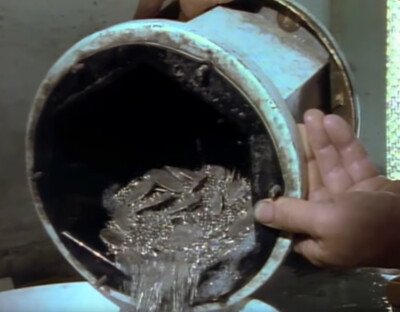
PREV ARTICLE
NEXT ARTICLE
FULL ISSUE
PREV FULL ISSUE
THE HORROR OF DRUM-POLISHED EIGHT REALESGary Beals submitted this article on a thankfully obsolete method of cleaning shipwreck coins. Thanks! -Editor
Oh, the horror —
A 1986 National Geographic television documentary shows recovered coins being tumbled in a pebble polishing drum accompanied by chemicals and hundreds of ball bearings. The sound on the documentary of those rare Spanish colonial coins and ¼-inch stainless steel ball bearings being tumbled is terrorizing to any serious coin lover. And to think that those coins may have spent hours in this metal drum being battered against its sides, with steel balls is a nightmare. As the camera zoomed in, the voice-over noted that the pieces were gleamingly shiny — just what the salvors wanted. There are still shots captured from the program: 
Thousands of the silver coins from the 1622 wrecks had yet more torture to endure at an artifact restoration (if that is the right word) lab. Specifically, silver 8 reales and 4 reales coins from portions of the Nuestra Señora de Atocha wreck found in the early 1970s. 
The drum of death — this device was a key tool is preparing coins for market from the mid-1970s until well into the 1980s. It belongs at the gift shop of a rock shop outside of Tucson helping to sell shiny agate pebbles to kids, not clanging cobs around in a caustic soup for hours.
Treatment in the drum completed, the 400-year old coins and the ball bearings were dumped from the drum and further sorted. The documentary noted the pieces received a
This treatment came after an electrolysis process, considered a quick and efficient way of cleaning corrosion off coins at the time. One specialist said: The only good news here: The Mel Fisher company stopped doing this sometime after 1986. Some auction houses have mentioned that the particular 8 reales pieces being sold were of a later date of discovery or processing and did not receive this treatment. But it appears that thousands of silver pieces suffered this fate for at least a decade. Where the numismatists were back then with coin treatment advice for the Fisher family is not known. An earlier National Geographic documentary in 1976 did not mention this process in its coverage of the impressive research and effort of the firm.

Wayne Homren, Editor The Numismatic Bibliomania Society is a non-profit organization promoting numismatic literature. See our web site at coinbooks.org. To submit items for publication in The E-Sylum, write to the Editor at this address: whomren@gmail.com To subscribe go to: https://my.binhost.com/lists/listinfo/esylum All Rights Reserved. NBS Home Page Contact the NBS webmaster 
|